A visit to Glimmingehus
Glimmingehus is a medieval castle located about an hour's drive from my home. If due to the coronavirus or not, only guided tours are available, every hour. I came 15 min before the first tour at 11 am, and got a ticket for the 1 pm tour. I spent the waiting time visiting the small, but interesting museum, walking around the castle, visiting the herb's garden, and the small park surrounding the estate. As I always have a book in my bag, I sat down at a picnic area to read while waiting for the tour to begin.
I always find guided tours interesting. They will tell you a little bit more about the history and the lives of the people living there. The estate has quite an interesting story, and we were treated with information about past and present times.
Glimmingehus was built 1499-1506, during an era when this place was part of Denmark. It is the best-preserved medieval stronghold in Scandinavia. Due to the troubled times in which it was built, it contains many of the defensive features of the era such as parapets, false doors, and dead-end corridors, 'murder-holes' for pouring boiling pitch over the attackers, moats, drawbridges, and other similar features. Being close to the sea, probably closer in those days than today, threats were imminent. Ulfstand, being somewhat of a pirate himself, probably knew very well what could be expected. However, Glimmingehus was never attacked.
It was built by the Danish knight Jens Holgersen Ulfstand. He hired stone-cutter-mason and architect Adam van Düren for the construction. He was from the northern part of Germany and also worked on Lund's Cathedral. Although the construction of the Cathedral started already in the 12th century, by the 16th century it was up for renovation and restoring after a fire.
Jens Holgersen Ulfstand was a very powerful and wealthy man, and rather nasty, as the story goes. He spent a lot of money and efforts in the building of Glimmingehus and archeological finds show the extravagant lifestyle of the family. Expensive objects at the time, such as Venetian glass, painted glass from the Rhine district, and Spanish ceramics have been found here. The interior also shows evidence of comfortable living with hot air channels in the walls, bench seats in the window recesses, and toilettes. The toilettes were accessed from the grand halls, contained a place to sit, and a hole straight down. Better not linger underneath if you were outside!
The house has, more or less, survived unscathed until today. It was close to being demolished in 1676 when the Swedish King Charles XI feated the castle would fall into the hands of the Danish king during the Scanian Wars. Luckily, it never happened.
In the south of Sweden, many churches and castles are built with a stepped gable as you see in the pictures. I really love this style. It was a medieval way of building, although most common in the south of Sweden, most likely because it was Danish at the time. Examples of this building style can be seen in cities of the Hanseatic League, and countries like Belgium, usually in Flanders, Netherlands, Germany, Denmark, and Sweden, among others.
On the way home I stopped by at Bollerup castle, built in a similar style. The castle is painted in a beautiful yellow colour. Today it is part of an upper secondary school specialised in natural resource uses










Beautiful
ReplyDeleteWhat a fascinating spot and what a terrific venue for a covid outing. It sounds like they take things seriously. I appreciate the history you shared with this. I, too, like that steep gable. It's very striking. Looks like a great day.
ReplyDeleteIt was great. A day spent in history is a great day for me!
DeleteSuch an interesting building! I like those stepped gables as well, we have them a lot in Northern Germany and I also saw them in Poland.
ReplyDeleteAren't they great? I have visited Stralsund and Wismar and love the old buildings there. Still to visit Lübeck and Rostock. Are you living close by these cities?
DeleteThat's a fascinating description. I'm glad to learn about this castle and its history, and see your photos.
ReplyDeletebe well... mae at maefood.blogspot.com